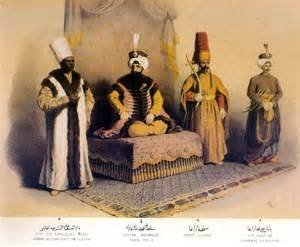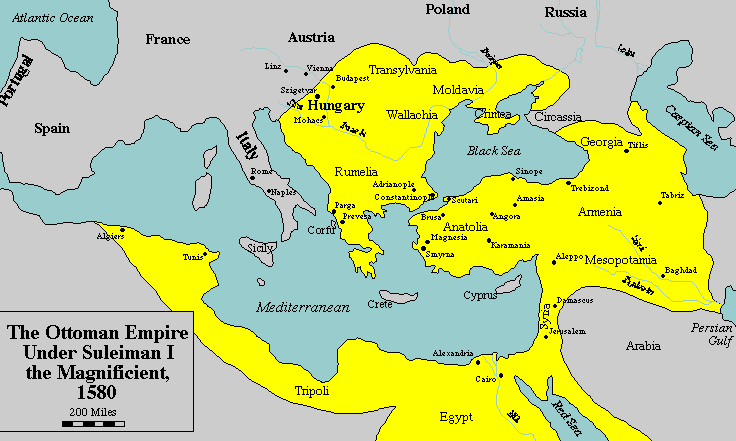The history of" OTTOMAN EMPIRE "

The Ottoman Empire was founded by Osman I. As sultan Mehmed II conquered Constantinople (today named Istanbul) in 1453, the state grew into a mighty empire. The Empire reached its apex under Suleiman the Magnificent in the 16th century when it stretched from the Persian Gulf in the east to Hungary in the northwest; and from Egypt in the south to the Caucasus in the north. The empire came to an end in the aftermath of its defeat by the Allies in World War I. The empire was dismantled by the Allies after the war ended in 1918.
Contents__
1 Rise of the Ottoman Empire (1299–1453)
2 Classical Age (1453–1550)
3 Transformation of the Ottoman Empire (1550–1700)
4 Stagnation and reform (1700–1827)
5 Decline and modernization (1828–1908) 5.1 Modernization 5.1.1 Railways
5.2 Crimean War
5.3 Ethnic nationalism
5.4 Balkans 5.4.1 Congress of Berlin
5.5 Egypt
5.6 Armenians
6 Defeat and dissolution (1908–1922) 6.1 World War I (1914–1918)
6.2 Turkish War of Independence (1919–1922)
7 Ottoman dynasty after dissolution
8 Fall of the Empire
9 See also
10 References
11 Further reading 11.1 General Surveys
11.2 The Early Ottomans
11.3 The Classical Age
11.4 Military
Rise of the Ottoman Empire (1299–1453)__
Main article: Rise of the Ottoman Empire
Further information: Ottoman Dynasty and Gaza Thesis
With the demise of the Seljuk Sultanate of Rum (c. 1300), Anatolia was divided into a patchwork of independent states, the so-called Anatolian Beyliks. By 1300, a weakened Byzantine Empire had lost most of its Anatolian provinces to these Turkish principalities. One of the beyliks was led by Osman I (d. 1323/4), from which the name Ottoman is derived, son of Ertuğrul, around Eskişehir in western Anatolia. In the foundation myth expressed in the story known as "Osman's Dream", the young Osman was inspired to conquest by a prescient vision of empire (according to his dream, the empire is a big tree whose roots spread through three continents and whose branches cover the sky).[1] According to his dream the tree, which was Osman's Empire, issued four rivers from its roots, the Tigris, the Euphrates, the Nile and the Danube.[1] Additionally, the tree shaded four mountain ranges, the Caucasus, the Taurus, the Atlas and the Balkan ranges.[1] During his reign as Sultan, Osman I extended the frontiers of Turkish settlement toward the edge of the Byzantine Empire.
In this period, a formal Ottoman government was created whose institutions would change drastically over the life of the empire.
In the century after the death of Osman I, Ottoman rule began to extend over the Eastern Mediterranean and the Balkans. Osman's son, Orhan, captured the city of Bursa in 1326 and made it the new capital of the Ottoman state. The fall of Bursa meant the loss of Byzantine control over Northwestern Anatolia. The important city of Thessaloniki was captured from the Venetians in 1387. The Ottoman victory at Kosovo in 1389 effectively marked the end of Serbian power in the region, paving the way for Ottoman expansion into Europe. The Battle of Nicopolis in 1396, widely regarded as the last large-scale crusade of the Middle Ages, failed to stop the advance of the victorious Ottoman Turks. With the extension of Turkish dominion into the Balkans, the strategic conquest of Constantinople became a crucial objective. The Empire controlled nearly all former Byzantine lands surrounding the city, but the Byzantines were temporarily relieved when Timur invaded Anatolia in the Battle of Ankara in 1402. He took Sultan Bayezid I as a prisoner. The capture of Bayezid I threw the Turks into disorder. The state fell into a civil war that lasted from 1402 to 1413, as Bayezid's sons fought over succession. It ended when Mehmed I emerged as the sultan and restored Ottoman power, bringing an end to the Interregnum.

Battle of Kosovo (1389)
Battle of Nicopolis (1396)
Sultan Mehmed I. Ottoman miniature, 1413-1421
Battle of Varna (1444)
Part of the Ottoman territories in the Balkans (such as Thessaloniki, Macedonia and Kosovo) were temporarily lost after 1402, but were later recovered by Murad II between the 1430s and 1450s. On 10 November 1444, Murad II defeated the Hungarian, Polish and Wallachian armies under Władysław III of Poland (also King of Hungary) and János Hunyadi at the Battle of Varna, which was the final battle of the Crusade of Varna.[2][3] Four years later, János Hunyadi prepared another army (of Hungarian and Wallachian forces) to attack the Turks, but was again defeated by Murad II at the Second Battle of Kosovo in 1448.
The son of Murad II, Mehmed the Conqueror, reorganized the state and the military, and demonstrated his martial prowess by capturing Constantinople on 29 May 1453, at the age of 21.
thnx for reading it....
nice post
Congratulations @ssst! You have received a personal award!
Click on the badge to view your Board of Honor.
Do not miss the last post from @steemitboard:
Congratulations @ssst! You received a personal award!
You can view your badges on your Steem Board and compare to others on the Steem Ranking
Vote for @Steemitboard as a witness to get one more award and increased upvotes!